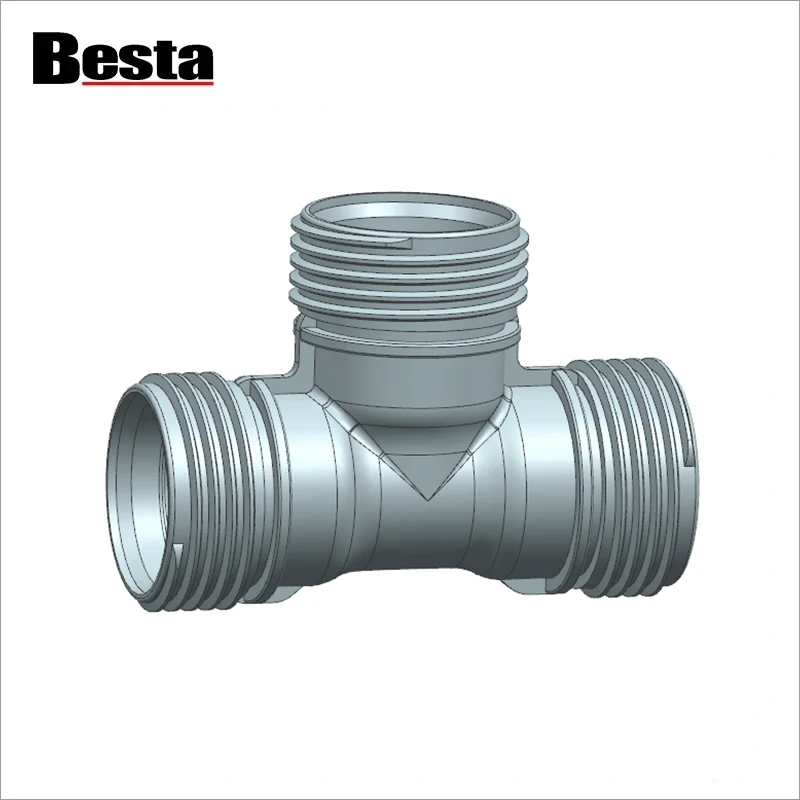- English
- Español
- Português
- русский
- Français
- 日本語
- Deutsch
- tiếng Việt
- Italiano
- Nederlands
- ภาษาไทย
- Polski
- 한국어
- Svenska
- magyar
- Malay
- বাংলা ভাষার
- Dansk
- Suomi
- हिन्दी
- Pilipino
- Türkçe
- Gaeilge
- العربية
- Indonesia
- Norsk
- تمل
- český
- ελληνικά
- український
- Javanese
- فارسی
- தமிழ்
- తెలుగు
- नेपाली
- Burmese
- български
- ລາວ
- Latine
- Қазақша
- Euskal
- Azərbaycan
- Slovenský jazyk
- Македонски
- Lietuvos
- Eesti Keel
- Română
- Slovenski
- मराठी
- Srpski језик
What Are the Most Common Applications for PP Compression Fitting Moulds?
2024-09-27

What is PP Compression Fitting Mould made of?
The PP Compression Fitting Mould is generally made of high-grade steel, which is hardened and polished to create the desired shape and finish. The material is selected for its durability, strength, and resistance to corrosion and wear. Additionally, the PP Compression Fitting Mould is often coated with a protective layer to prevent rust and oxidation, further enhancing its lifespan and performance.
What are the advantages of using PP Compression Fitting Mould?
The PP Compression Fitting Mould has several advantages over other types of compression fitting molds. Firstly, it is reliable and efficient in producing high-quality compression fittings with consistent measurements and specifications. Secondly, it can be customized to produce fittings of different sizes, shapes, and styles, making it suitable for a wide range of applications. Finally, the PP Compression Fitting Mould is easy to use, maintain, and repair, ensuring optimal performance and longevity.
How is PP Compression Fitting Mould used in the manufacturing process?
The PP Compression Fitting Mould is used in the manufacturing process to produce polypropylene compression fittings using a compression molding technique. The raw material, which is usually polypropylene plastic, is melted and pressed into the desired shape and size using the PP Compression Fitting Mould. The mold is then cooled to allow the plastic to harden and retain its shape. The resulting compression fittings are then removed from the mold and subjected to quality control checks before being packaged and shipped to customers.
In conclusion, the PP Compression Fitting Mould plays a critical role in the production of compression fittings for polypropylene pipes. Its durability, reliability, and versatility make it an indispensable tool for plumbing and pipeline systems. At Ningbo Ouding Building Material Technology Co., Ltd., we specialize in manufacturing high-quality PP Compression Fitting Moulds and other building materials for use in various applications. Contact us at devy@albestahk.com to learn more about our products and services.
Scientific Research Papers on PP Compression Fitting Mould:
Wang, D., Wu, W., Wang, G., Li, Q., & Li, H. (2014). Finite element simulation and optimization of injection molding process for PP compression fitting. Applied Mechanics and Materials, 523, 480-483.
Wang, D., Wu, W., Wang, G., Li, Q., & Li, H. (2018). Simulation and optimization of injection molding process for PP compression fitting with core-pulling mechanism. The International Journal of Advanced Manufacturing Technology, 98(5-8), 1751-1765.
Butsev, V. S., & Tarasenko, Y. A. (2012). Theoretical and experimental investigation of processing parameters affecting mechanical properties of polypropylene–pipe fittings produced by compression moulding. International Communications in Heat and Mass Transfer, 39(1), 125-130.
Yu, L. L., Zhou, L. C., He, D. C., & Li, X. Y. (2014). Mechanical behavior of polypropylene pipes with different types of compression fittings under different loading conditions. Proceedings of the Institution of Mechanical Engineers, Part L: Journal of Materials: Design and Applications, 228(1), 13-30.
Liu, Y., Lu, W., & Chen, Y. (2019). Effects of female taper angle and undercut on release force and tightness of PP compression fittings. Applied Mechanics and Materials, 907, 165-168.
Wu, W., Duan, J., & Liu, D. (2018). Optimization analysis of injection molding process parameters for PP compression fittings. Applied Mechanics and Materials, 882, 470-474.
Lu, H., Zhu, M., Li, J., Wang, H., & Liu, J. (2019). Structural optimization design of PP-R plastic reducer based on numerical simulation of fluid characteristics. Journal of Cleaner Production, 231, 1443-1455.
Koksal, T. A., Ertaş, M., & Nar, M. (2018). Experimental and numerical investigation of flow behavior in compression fitting used for water supply pipes. Polymer Composites, 39(S1), E2273-E2281.
Liu, Y., Lu, W., & Chen, Y. (2017). Effects of mold temperature on the dimensional stability of PP compression fittings. Applied Mechanics and Materials, 880, 27-30.
Yang, Z., Xu, J., & Li, S. (2016). Investigation of compression molding process parameters on processing window, ovality and dimensional accuracy of PP branch pipe with extrusion sheet technology. Journal of Materials Processing Technology, 233, 147-162.
Tiuc, A. E., Geormaneanu, A., Ciofu, C., & Rosca, I. C. (2019). Process optimization for the manufacturing of polypropylene fittings by injection compression molding. International Journal of Advanced Manufacturing Technology, 102(5-8), 2253-2267.




